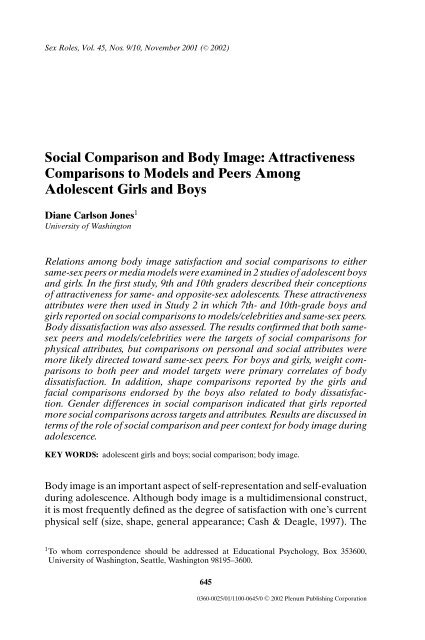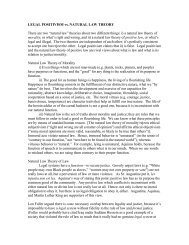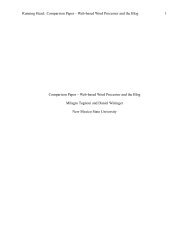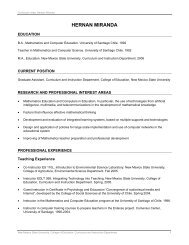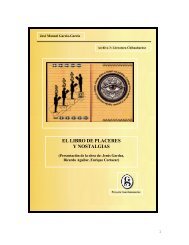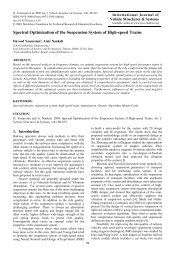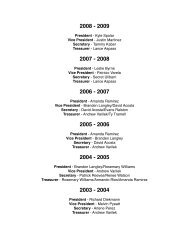Social Comparison and Body Image: Attractiveness Comparisons to ...
Social Comparison and Body Image: Attractiveness Comparisons to ...
Social Comparison and Body Image: Attractiveness Comparisons to ...
You also want an ePaper? Increase the reach of your titles
YUMPU automatically turns print PDFs into web optimized ePapers that Google loves.
Sex Roles, Vol. 45, Nos. 9/10, November 2001 ( C○ 2002)<br />
<strong>Social</strong> <strong>Comparison</strong> <strong>and</strong> <strong>Body</strong> <strong>Image</strong>: <strong>Attractiveness</strong><br />
<strong>Comparison</strong>s <strong>to</strong> Models <strong>and</strong> Peers Among<br />
Adolescent Girls <strong>and</strong> Boys<br />
Diane Carlson Jones 1<br />
University of Washing<strong>to</strong>n<br />
Relations among body image satisfaction <strong>and</strong> social comparisons <strong>to</strong> either<br />
same-sex peers or media models were examined in 2 studies of adolescent boys<br />
<strong>and</strong> girls. In the first study, 9th <strong>and</strong> 10th graders described their conceptions<br />
of attractiveness for same- <strong>and</strong> opposite-sex adolescents. These attractiveness<br />
attributes were then used in Study 2 in which 7th- <strong>and</strong> 10th-grade boys <strong>and</strong><br />
girls reported on social comparisons <strong>to</strong> models/celebrities <strong>and</strong> same-sex peers.<br />
<strong>Body</strong> dissatisfaction was also assessed. The results confirmed that both samesex<br />
peers <strong>and</strong> models/celebrities were the targets of social comparisons for<br />
physical attributes, but comparisons on personal <strong>and</strong> social attributes were<br />
more likely directed <strong>to</strong>ward same-sex peers. For boys <strong>and</strong> girls, weight comparisons<br />
<strong>to</strong> both peer <strong>and</strong> model targets were primary correlates of body<br />
dissatisfaction. In addition, shape comparisons reported by the girls <strong>and</strong><br />
facial comparisons endorsed by the boys also related <strong>to</strong> body dissatisfaction.<br />
Gender differences in social comparison indicated that girls reported<br />
more social comparisons across targets <strong>and</strong> attributes. Results are discussed in<br />
terms of the role of social comparison <strong>and</strong> peer context for body image during<br />
adolescence.<br />
KEY WORDS: adolescent girls <strong>and</strong> boys; social comparison; body image.<br />
<strong>Body</strong> image is an important aspect of self-representation <strong>and</strong> self-evaluation<br />
during adolescence. Although body image is a multidimensional construct,<br />
it is most frequently defined as the degree of satisfaction with one’s current<br />
physical self (size, shape, general appearance; Cash & Deagle, 1997). The<br />
1 To whom correspondence should be addressed at Educational Psychology, Box 353600,<br />
University of Washing<strong>to</strong>n, Seattle, Washing<strong>to</strong>n 98195–3600.<br />
645<br />
0360-0025/01/1100-0645/0 C○ 2002 Plenum Publishing Corporation
646 Jones<br />
importance of body image is evident in its relationship <strong>to</strong> risk status for<br />
eating disorders, depression, <strong>and</strong> low self esteem (Attie & Brooks-Gunn,<br />
1989; Harter, 1998; Leon, Fulkerson, Perry, & Cudeck, 1993; Ricciardelli &<br />
McCabe, 2001; Richards, Casper, & Larson, 1990).<br />
One fac<strong>to</strong>r that has been considered a central contribu<strong>to</strong>r <strong>to</strong> body image<br />
is social comparison. <strong>Social</strong> comparison refers <strong>to</strong> the cognitive judgments<br />
that people make about their own attributes compared <strong>to</strong> others. The<br />
comparisons are pivotal <strong>to</strong> self-evaluations <strong>and</strong> depend less on objective<br />
circumstances than on how one judges the self in relation <strong>to</strong> others on a<br />
particular attribute (Wood, 1989). In theory, individuals prefer <strong>to</strong> compare<br />
themselves <strong>to</strong> others who are similar for the attribute of concern (Miller,<br />
Turnbull, & McFarl<strong>and</strong>, 1988). <strong>Social</strong> comparison can also be employed <strong>to</strong><br />
gather information about highly valued attributes, social expectations, <strong>and</strong><br />
norms (Ruble, 1983; Wood, 1989) so that comparisons may be made <strong>to</strong> a<br />
variety of targets.<br />
The empirical relationship between social comparison <strong>and</strong> body image<br />
has been evaluated among college students, primarily for women. The<br />
general finding has been that females who have reported more appearancerelated<br />
social comparisons have been more likely <strong>to</strong> be dissatisfied with their<br />
body images (Faith, Leone, & Allison, 1997; S<strong>to</strong>rmer & Thompson, 1996;<br />
Thompson, Coovert, & S<strong>to</strong>rmer, 1999). The linkage between social comparison<br />
<strong>and</strong> negative body image may be enhanced in the research because the<br />
targets of the appearance comparisons have frequently been models <strong>and</strong><br />
celebrities presented in the media (Botta, 1999; Taylor et al., 1998). Media<br />
images of thin females <strong>and</strong> muscular males represent idealized versions of<br />
physical attractiveness. Analyses of appearance magazines have revealed a<br />
steady bombardment of images that have underscored the importance of<br />
idealized appearance (Cusumano & Thompson, 1997; Spitzer, Henderson,<br />
& Zivian, 1999). The repeated media images of thin females <strong>and</strong> muscular<br />
males make these forms seemingly the st<strong>and</strong>ard of attractiveness. <strong>Social</strong><br />
comparison <strong>to</strong> these idealized images then appears <strong>to</strong> promote a discrepancy<br />
between the attractiveness of self <strong>and</strong> other, leading <strong>to</strong> a more negative<br />
evaluation of self.<br />
The existing research provides evidence supporting the relevance of<br />
social comparison for body image evaluation. There are, however, several<br />
limitations <strong>to</strong> note. First, there is little information on appearance-related<br />
social comparisons during adolescence even though there are clear indications<br />
that social comparison is employed by early adolescents <strong>to</strong> evaluate<br />
their academic competence among peers (Ruble, 1983). Given the physical<br />
changes associated with puberty <strong>and</strong> the importance of appearance for selfesteem,<br />
knowledge about the development of appearance social comparison<br />
for both boys <strong>and</strong> girls may be particularly helpful in underst<strong>and</strong>ing the
<strong>Social</strong> <strong>Comparison</strong> <strong>and</strong> <strong>Body</strong> <strong>Image</strong> 647<br />
dynamics associated with the changes <strong>and</strong> expectations surrounding body<br />
image.<br />
Second, previous research has not considered the role of social comparison<br />
in the body image satisfaction of males so that gender differences <strong>and</strong><br />
similarities in social comparison have not been explored. Although the body<br />
satisfaction has typically been higher among males than among females, the<br />
body image concerns of males have reportedly increased in recent years <strong>and</strong><br />
have been linked <strong>to</strong> adjustment issues (Abell & Richards, 1996; Cohane &<br />
Pope, 2001; Lerner et al., 1991). Given the significant relationship between<br />
social comparison <strong>and</strong> negative body image in college women, it is important<br />
<strong>to</strong> evaluate the role of social comparison in the self-evaluation of body<br />
image for adolescent males as well.<br />
Third, existing research has focused primarily on models/celebrities as<br />
targets for appearance comparisons during adolescence. However, comparison<br />
targets can be selected not only from the distal world of the media,<br />
but also from everyday life. Peers are a vital part of the lives of adolescents<br />
<strong>and</strong> play an increasingly prominent role in defining social expectations,<br />
establishing identity, <strong>and</strong> evaluating self (Brown, Mory, & Kinney, 1994).<br />
Feeling accepted <strong>and</strong> supported by friends <strong>and</strong> classmates is indeed one<br />
of the central concerns of adolescents (Bukowski, Hoza, & Boivin, 1993).<br />
Furthermore, studies have indicated that students at a young age are cognizant<br />
of the linkage between conforming <strong>to</strong> appearance expectations <strong>and</strong><br />
acceptance among peers (Oliver & Thelen, 1996). During adolescence, girls<br />
have reported that they feel like they are being judged on appearance <strong>and</strong><br />
are pressured by peers <strong>to</strong> conform <strong>to</strong> appearance expectations (Merten,<br />
1996; Milkie, 1999; Pax<strong>to</strong>n, Schutz, Wertheim, & Muir, 1999; Taylor et al.,<br />
1998).<br />
Given that appearance is one of the potential routes <strong>to</strong> acceptance <strong>and</strong><br />
popularity, social comparison becomes a relevant mechanism for learning<br />
about the appearance-related social expectations among peers <strong>and</strong> for evaluating<br />
the self in terms of those st<strong>and</strong>ards. Yet peers as targets of social<br />
comparison have not figured prominently in the literature. When classmates<br />
have been distinguished as targets of appearance comparisons among college<br />
women, these comparisons have resulted in heightened body dissatisfaction<br />
(Heinberg & Thompson, 1992a, 1992b). Unfortunately, research<br />
has not focused on the frequency with which adolescent girls <strong>and</strong> boys<br />
select peers as targets of social comparison compared with models <strong>and</strong><br />
celebrities.<br />
Fourth, previous research has not specified the particular attractiveness<br />
attributes that are involved in appearance social comparisons, but have assessed<br />
attractiveness as a global phenomenon. However, reliance upon such<br />
a global approach does not permit an analysis of the relevance of various
648 Jones<br />
attributes for social comparison processes. Attention <strong>to</strong> specific attributes<br />
is important because gender differences in the attributes contributing <strong>to</strong><br />
attractiveness <strong>and</strong> body satisfaction have been noted. For example, personality<br />
characteristics have been confirmed as determinants of physical<br />
attractiveness ratings, especially those made by college females (Jensen-<br />
Campbell, Graziano, & West, 1995). Furthermore, previous research has<br />
identified gender differences in the attributes associated with body image.<br />
Weight has been a primary feature predicting body dissatisfaction among<br />
females whereas the attractiveness concerns of males have been associated<br />
with height <strong>and</strong> shoulders/muscular shape (Abell & Richards, 1996; Franzoi<br />
& Herzog, 1987; Graziano, Brothen, & Berscheid, 1978). It is through examining<br />
specific attractiveness attributes that a better underst<strong>and</strong>ing of<br />
social comparison <strong>and</strong> body image for adolescent boys <strong>and</strong> girls will be<br />
possible.<br />
The purpose of the current research was <strong>to</strong> overcome limitations in<br />
previous studies by examining attractiveness social comparison during adolescence<br />
through the self-reports of boys <strong>and</strong> girls from 7th <strong>and</strong> 10th grades.<br />
The research was guided by four questions. What are the attributes of attractiveness<br />
as defined by adolescents? Are there gender differences in these<br />
attractiveness attributes? Are there differences in the frequency with which<br />
adolescent boys <strong>and</strong> girls report same-sex peers or models as targets of social<br />
comparisons? Are there differential relationships in targets/attributes<br />
of social comparison <strong>and</strong> body image satisfaction?<br />
The answers <strong>to</strong> these questions were obtained in two separate studies.<br />
In the first study, participants described their conceptions of attractiveness<br />
for same- <strong>and</strong> opposite-sex adolescents. These attractiveness attributes were<br />
then used in Study 2 <strong>to</strong> assess the self-reported frequency with which adolescents<br />
compared themselves <strong>to</strong> model/celebrities or peers <strong>and</strong> <strong>to</strong> determine<br />
the relationship between social comparison <strong>and</strong> body image satisfaction for<br />
boys <strong>and</strong> girls.<br />
STUDY 1<br />
The first goal of this initial study was <strong>to</strong> identify the features that define<br />
ideal attractiveness for adolescents. Previous studies that have assessed<br />
cultural st<strong>and</strong>ards or ideals have either been limited <strong>to</strong> college students who<br />
were provided a specific set of attributes such as weight or shape (Fallon &<br />
Rozin, 1985) or a st<strong>and</strong>ardized list of body parts for participants <strong>to</strong> evaluate<br />
(Franzoi & Herzog, 1987). These constrained approaches have not necessarily<br />
captured the range of attractiveness features that may be salient <strong>to</strong> adolescents.<br />
Therefore, an open-ended format was used <strong>to</strong> elicit the attractiveness
<strong>Social</strong> <strong>Comparison</strong> <strong>and</strong> <strong>Body</strong> <strong>Image</strong> 649<br />
attributes so that the elements most central <strong>to</strong> adolescents’ ideal attractiveness<br />
conceptions could be identified.<br />
An additional purpose of this study was <strong>to</strong> examine the gender differences<br />
<strong>and</strong> similarities in the conceptions of attractiveness among teenage<br />
boys <strong>and</strong> girls. As noted earlier, there are gender differences in the attributes<br />
that contribute <strong>to</strong> attractiveness judgments. It is unclear from existing research<br />
if both female <strong>and</strong> male adolescents endorse these attractiveness<br />
attributes for same- <strong>and</strong> opposite-sex peers. Even though there is some evidence<br />
of congruence in the physical features defining attractiveness (Franzoi<br />
& Herzog, 1987) for college males <strong>and</strong> females, other research reveals that<br />
adolescents (Cohn et al., 1987) <strong>and</strong> college students (Fallon & Rozin, 1985)<br />
hold dis<strong>to</strong>rted perceptions of opposite-sex preferences. In addition, nonphysical<br />
characteristics have been identified as important determinants of<br />
physical attractiveness judgments, especially those made by females (Jensen-<br />
Campbell et al., 1995).<br />
Method<br />
Participants<br />
The sample included 42 girls <strong>and</strong> 38 boys in 9th <strong>and</strong> 10th grades of a<br />
public high school. The participants were 98% White <strong>and</strong> middle- <strong>to</strong> uppermiddle<br />
class. Passive parental consent <strong>and</strong> student assent were provided.<br />
Measures<br />
<strong>Attractiveness</strong> Attributes. In classroom settings, the students responded<br />
<strong>to</strong> a survey in which they were asked <strong>to</strong> write a description of their ideal image<br />
of attractiveness for both a teenage girl <strong>and</strong> for a teenage boy. In this way, the<br />
same-sex <strong>and</strong> opposite-sex attractiveness conceptions were obtained from<br />
both boys <strong>and</strong> girls.<br />
The open-ended, written responses were reviewed <strong>to</strong> establish conceptual<br />
categories for the attractiveness attributes. Responses were then<br />
coded in<strong>to</strong> eight mutually exclusive categories representing physical attributes<br />
(height, weight, shape, facial features) <strong>and</strong> personal/social attributes<br />
(personality, intelligence, style, popularity). A complete description of the<br />
categories is presented in Table I. All responses that did not fit in<strong>to</strong> one of<br />
these categories were coded as “other.” Students received a score of “1”<br />
if a category was presented in the description, regardless of the number<br />
of times the category was represented. Interrater reliabilities between two<br />
coders were calculated on 25% of the pro<strong>to</strong>cols <strong>and</strong> ranged from 81 <strong>to</strong> 94%<br />
agreement.
650 Jones<br />
Table I. Categories for <strong>Attractiveness</strong> Attributes<br />
1. Height: Aspects of stature, for example, tall/short, average height, or a specific height<br />
(e.g., 5’8”)<br />
2. Weight: Aspects of heaviness, for example, slim, not fat, not chunky, average weight, or<br />
a specific weight (e.g., 120 pounds)<br />
3. Shape/build: Aspects of form or configuration of body (e.g., girls: body in proportion <strong>to</strong><br />
bone structure, small frame, nice figure; boys: good muscle <strong>to</strong>ne, muscular built)<br />
4. Face: Description of facial features, for example, pretty, good-looking, good<br />
complexion, strong chin<br />
5. Personality: Aspects of personality <strong>and</strong> identity, for example, nice, friendly, outgoing,<br />
look happy, stable, no ego, know who they are<br />
6. Intelligence/achievement: Aspects of school performance <strong>and</strong> intelligence, for example,<br />
good student, smart, “A” student<br />
7. Style: Aspects of grooming <strong>and</strong> clothes, for example, dresses well, grooms well, dresses<br />
“cool”<br />
8. Popularity: Aspects of peer relationships, for example, has friends, is popular<br />
9. Other: Aspects that were not coded in<strong>to</strong> any of the previous categories<br />
Results<br />
<strong>Attractiveness</strong> Features for Teenage Girls<br />
Table II presents the percentage of boys <strong>and</strong> girls who indicated that<br />
physical <strong>and</strong> personal/interpersonal features were associated with ideal attractiveness<br />
features of a teenage girl. An inspection of the percentages <strong>and</strong><br />
the outcomes of chi-square tests revealed that both adolescent girls <strong>and</strong> boys<br />
endorsed height, weight, <strong>and</strong> facial characteristics as prominent attractiveness<br />
features for females.<br />
The personal/social attributes of female attractiveness revealed distinct<br />
gender differences. More girls than boys consistently incorporated<br />
Table II. Percentage of Adolescents Reporting the <strong>Attractiveness</strong> Attributes for Ideal Teenage<br />
Girls <strong>and</strong> Ideal Teenage Boys by Gender<br />
Ideal teenage girl features Ideal teenage boy features<br />
Girls (%) Boys (%) Girls (%) Boys (%)<br />
Physical attributes<br />
Height 45 32 51 53<br />
Weight 59 57 17 13<br />
Shape/build 08 14 83 77<br />
Face 83 87 93 50∗ Personal/social attributes<br />
Personality 80 68 78 37∗ Intelligence 43 22∗ 34 13∗ Style 40 16∗ 32 23<br />
Popularity 23 05∗ 15 07<br />
∗Significant gender difference, ps at least
<strong>Social</strong> <strong>Comparison</strong> <strong>and</strong> <strong>Body</strong> <strong>Image</strong> 651<br />
these features in<strong>to</strong> their descriptions of attractive females. Specifically, more<br />
girls mentioned intelligence, χ 2 (1, N = 77) = 3.8, p
652 Jones<br />
with previous research with college students that has noted the consensual<br />
nature of attractiveness st<strong>and</strong>ards among males <strong>and</strong> females (Franzoi &<br />
Herzog, 1987; Parker et al., 1995). The results from the current study suggest<br />
that similar st<strong>and</strong>ards of physical attractiveness are evident for ideal<br />
visions of both adolescent boys <strong>and</strong> girls as generated by both males <strong>and</strong><br />
females.<br />
Gender similarity was not as evident for the Personal/<strong>Social</strong> attributes<br />
of attractiveness. Although it was notable that physical features alone did not<br />
define attractiveness, it was the girls who were more likely <strong>to</strong> include these<br />
attributes in their visions of adolescent attractiveness. This pattern of results<br />
conforms <strong>to</strong> the gender differences that have emerged from other studies<br />
on attractiveness (Feingold, 1990; Graziano, Jensen-Campbell, Shebilske,<br />
& Lundgren, 1993). The present study contributes <strong>to</strong> this body of research<br />
by substantiating that young adolescent girls incorporate several personal<br />
<strong>and</strong> social attributes in<strong>to</strong> their judgments of attractiveness for females <strong>and</strong><br />
males. From a developmental perspective, it is interesting <strong>and</strong> important that<br />
a broad range of characteristics is clearly part of the attractiveness conceptions<br />
of adolescents as they begin <strong>to</strong> engage in the tasks of self-definition<br />
<strong>and</strong> evaluation. It would seem that adolescents not only have multiple dimensions<br />
on which they base their self-worth (Harter, 1998), but that they<br />
further differentiate within domains in ways that have implications for self<br />
<strong>and</strong> other. In the case of attractiveness, the greater array of ideal features<br />
may also carry with it the burden of greater expectations for self <strong>and</strong> other,<br />
particularly for the adolescent girls.<br />
STUDY 2<br />
The findings from Study 1 verified the commonality in the conceptions<br />
that form individual adolescent’s ideal images of physical attractiveness regardless<br />
of gender. Physical attractiveness was not just in the eye of the<br />
beholder in this sample, but had a solid consensual basis that was shared<br />
among adolescents. It is not known, however, if these features are used in<br />
appearance-related social comparisons, if they are relevant across targets of<br />
comparison, or if they are related <strong>to</strong> body satisfaction. Therefore, the purpose<br />
of Study 2 was <strong>to</strong> examine the self-reported frequency of social comparisons<br />
<strong>to</strong> models/celebrities <strong>and</strong> same-sex peers across the attractiveness features<br />
for boys <strong>and</strong> girls.<br />
Because of the importance of peers in the lives of adolescents <strong>and</strong> their<br />
greater similarity as social comparison targets (Miller et al., 1988), it was<br />
predicted that peers would be the more frequent targets of social comparison<br />
than models, especially for the personal/social attributes. These attributes
<strong>Social</strong> <strong>Comparison</strong> <strong>and</strong> <strong>Body</strong> <strong>Image</strong> 653<br />
correspond <strong>to</strong> arenas of social status <strong>and</strong> organization within the school<br />
context <strong>and</strong> represent central issues in the lives of many adolescents (Brown<br />
et al., 1994; Youniss, McLellan, & Strouse, 1994).<br />
Gender differences in the rates of social comparison were also expected.<br />
The greater cultural emphasis upon physical attractiveness for women was<br />
the basis for predicting that girls would report higher levels of social comparison.<br />
At the same time, because of the importance of body image for selfevaluation<br />
for both males <strong>and</strong> females, it was expected that attractivenessrelated<br />
social comparisons would be related <strong>to</strong> body dissatisfaction<br />
regardless of gender. The salient attributes, though, would vary by gender<br />
such that weight would be the more prominent contribu<strong>to</strong>r for girls <strong>and</strong><br />
muscular build for boys.<br />
Method<br />
Participants<br />
The sample included 174 seventh graders (92 girls <strong>and</strong> 82 boys, Mean<br />
age = 12.6 years) <strong>and</strong> 241 tenth graders (123 girls <strong>and</strong> 118 boys, Mean age =<br />
15.5 years). The students were primarily from middle- <strong>to</strong> upper-middle-class<br />
backgrounds. Self-reports of ethnic background revealed that the majority<br />
of the students were White (71%). The sample also included Asian (18%),<br />
Hispanic (3%), <strong>and</strong> African American (1%) respondents. Participants provided<br />
parental consent <strong>and</strong> student assent.<br />
Measures<br />
The questionnaires were administered in regular class periods. Only a<br />
portion of the measures is reported here.<br />
<strong>Social</strong> <strong>Comparison</strong>s <strong>to</strong> Models <strong>and</strong> Peers. Participants were asked <strong>to</strong> rate<br />
how frequently they compared themselves <strong>to</strong> two different targets (models<br />
or peers) on the attractiveness attributes identified in Study 1. One item<br />
was made gender relevant: Girls rated “shape” as an attribute whereas boys<br />
rated “build.” Students indicated how often they compared themselves with<br />
models/celebrities by rating each feature on a scale from 1 (Never) <strong>to</strong>5<br />
(A lot). The students also rated the similar set of appearance attributes in<br />
terms of same-sex peers at schools. The scales for models <strong>and</strong> same-sex peers<br />
were presented separately at different points in the questionnaire. Order of<br />
presentation was r<strong>and</strong>omly assigned.<br />
<strong>Body</strong> <strong>Image</strong> Satisfaction. The <strong>Body</strong> Dissatisfaction Scale from the Eating<br />
Disorder Inven<strong>to</strong>ry (Garner, Olmstead, & Polivy, 1983) evaluated the<br />
level of satisfaction with general shape <strong>and</strong> specific body parts. The items on
654 Jones<br />
hips <strong>and</strong> thighs from the original scale were retained for the girls, but were<br />
altered for the boys <strong>to</strong> assess their satisfaction with chest <strong>and</strong> bicep size. The<br />
selection of these specific body parts for the boys was based conceptually<br />
on the relevance of upper body muscularity for boys <strong>and</strong> empirically on<br />
fac<strong>to</strong>r loadings for evaluating male body esteem (Franzoi & Shields, 1984).<br />
The final scales had adequate internal reliability for girls (α = .88) <strong>and</strong> boys<br />
(α = .82).<br />
<strong>Body</strong> Mass Index. <strong>Body</strong> size has been implicated in the development<br />
of body image dissatisfaction (Rosenblum & Lewis, 1999). Therefore, body<br />
mass index was used in the design as a control variable. Previous research has<br />
established that self-reported weight <strong>and</strong> height are reliable (Brooks-Gunn,<br />
Warren, Rosso, & Gargiulo, 1987). From the students’ self-reported height<br />
<strong>and</strong> weight, a body mass index was computed using the formula, <strong>Body</strong> Mass<br />
Index (BMI) = kg/m 2 .<br />
Results<br />
<strong>Social</strong> <strong>Comparison</strong>s <strong>to</strong> Models/Celebrities <strong>and</strong> Peers<br />
A series of Gender (2) × Grade (2) × (Target) (2) repeated-measures<br />
ANOVAs evaluated differences in the levels of reported social comparison<br />
<strong>to</strong> models <strong>and</strong> peers on Physical <strong>Attractiveness</strong> (height, weight, shape, <strong>and</strong><br />
face) <strong>and</strong> Personal/<strong>Social</strong> Attributes (style, personality, intelligence, popularity).<br />
Repeated-measures analyses are the appropriate technique when<br />
comparing similar measures rated by the same individuals. Because of the<br />
multiple number of analyses, Bonferroni’s correction was used <strong>to</strong> set the<br />
significance level at p
<strong>Social</strong> <strong>Comparison</strong> <strong>and</strong> <strong>Body</strong> <strong>Image</strong> 655<br />
Table III. Means <strong>and</strong> St<strong>and</strong>ard Deviations for <strong>Social</strong> <strong>Comparison</strong> <strong>to</strong> Models <strong>and</strong> Same-Sex<br />
Peers by Gender<br />
Girls Boys<br />
Models Same-sex Models Same-sex<br />
celebrities peers celebrities peers Significant fac<strong>to</strong>rs<br />
Physical attributes<br />
Height 2.05 (1.21) 2.38 (1.22) 1.81 (1.05) 2.55 (1.21) Target; Target ×<br />
Gender<br />
Weight 2.86 (1.34) 2.98 (1.27) 1.90 (1.05) 2.36 (1.13) Target; Target ×<br />
Gender<br />
Shape/build 3.12 (1.24) 2.95 (1.27) 2.62 (1.00) 2.69 (1.15) Sex; Grade<br />
Face 3.20 (1.33) 3.16 (1.30) 2.45 (1.32) 2.40 (1.23) Sex; Grade<br />
Personal/social<br />
attributes<br />
Personality 2.24 (1.25) 3.16 (1.31) 2.23 (1.20) 2.64 (1.25) Target; Target ×<br />
Gender; Target ×<br />
Grade<br />
Intelligence 2.22 (1.26) 2.93 (1.31) 2.34 (1.34) 2.91 (1.29) Target<br />
Style 3.28 (1.26) 3.36 (1.21) 2.68 (1.31) 2.75 (1.25) Sex<br />
Popularity 2.37 (1.26) 2.94 (1.33) 2.36 (1.30) 2.76 (1.22) Target; Target ×<br />
Grade<br />
Personality comparisons were more likely <strong>to</strong> be directed at same-sex peers<br />
(M = 2.87) than models (M = 2.25), F(1, 404) = 123.48, p
656 Jones<br />
the attributes were shape/build (Ms = 3.14 vs. 2.43) <strong>and</strong> face (Ms = 3.02<br />
vs. 2.50).<br />
Relationships Between <strong>Body</strong> Dissatisfaction<br />
<strong>and</strong> Reported <strong>Social</strong> <strong>Comparison</strong><br />
Pearson correlations were calculated separately by gender <strong>to</strong> assess the<br />
relationships between body dissatisfaction <strong>and</strong> the social comparison rates<br />
for physical <strong>and</strong> personal/social attributes. The analyses were also done separately<br />
for each target <strong>and</strong> attribute in order <strong>to</strong> identify differential patterns<br />
within <strong>and</strong> across the domains of attractiveness. Bonferroni’s correction for<br />
Type I error set the significance level at p
<strong>Social</strong> <strong>Comparison</strong> <strong>and</strong> <strong>Body</strong> <strong>Image</strong> 657<br />
were calculated separately by gender. The attractiveness attributes that had<br />
significant zero-order relationships with body dissatisfaction were selected<br />
as the predic<strong>to</strong>r variables in the separate analyses for models/celebrities <strong>and</strong><br />
same-sex peer targets. In each case, BMI <strong>and</strong> grade were entered as control<br />
variables.<br />
The multiple regressions equations were significant, Girls: Models,<br />
F(6, 207) = 32.73, p
658 Jones<br />
were the targets. Among the boys, weight <strong>and</strong> facial comparisons <strong>to</strong> both<br />
peers <strong>and</strong> models/celebrities were related <strong>to</strong> body dissatisfaction. Finally,<br />
the variance accounted for in body dissatisfaction was substantial for the<br />
girls <strong>and</strong> modest for the boys.<br />
Discussion<br />
The results of this study highlight both gender similarities <strong>and</strong> differences<br />
in social comparison <strong>and</strong> its relationship <strong>to</strong> body image. Both adolescent<br />
girls <strong>and</strong> boys use the multiple attractiveness attributes identified<br />
in Study 1 for social comparison when the targets are models/celebrities<br />
<strong>and</strong> peers. The reported social comparisons encompassed the range of attributes<br />
embedded in the conceptions of ideal attractiveness during adolescence<br />
rather than being limited <strong>to</strong> the most consensual or highly endorsed<br />
attributes.<br />
The patterns of comparisons <strong>to</strong> peers or models provide additional evidence<br />
of gender similarities. Peers tended <strong>to</strong> be the more frequent targets<br />
of social comparison for both girls <strong>and</strong> boys, especially for height, weight,<br />
personality, intelligence, <strong>and</strong> popularity. The results support the general expectation<br />
from the social comparison literature that individuals prefer <strong>to</strong><br />
make comparisons <strong>to</strong> similar others (Miller et al., 1988). In addition, certain<br />
attributes such as popularity <strong>and</strong> intelligence may be more relevant <strong>to</strong> both<br />
acceptance <strong>and</strong> performance within the school context (Brown et al., 1994)<br />
making peers more salient targets. Another possible reason for the preference<br />
for peer targets may be the difficulty of obtaining information about<br />
certain attributes from two-dimensional representations in the media. It is<br />
through personal interactions that knowledge about these attributes can be<br />
more readily obtained.<br />
Although peers were more frequently the targets of attractiveness comparisons,<br />
models were certainly identified as targets as well. For example,<br />
there were no differences in the rates at which students reported comparing<br />
themselves <strong>to</strong> models or peers when the attributes were style, shape/build,<br />
<strong>and</strong> face. Furthermore, girls reported comparable levels of social comparison<br />
across targets for weight; for boys, similar rates of social comparison were<br />
noted for build. It is apparent that popular appearance culture represented<br />
by media models <strong>and</strong> celebrities as well as the proximal appearance culture<br />
of same-sex peers at school are both relevant sources for judging the self <strong>and</strong><br />
gathering information especially about physical attractiveness attributes.<br />
<strong>Social</strong> comparisons <strong>to</strong> peers <strong>and</strong> <strong>to</strong> models/celebrities also share a similar<br />
relationship <strong>to</strong> body dissatisfaction. Indeed, comparisons <strong>to</strong> peer targets
<strong>Social</strong> <strong>Comparison</strong> <strong>and</strong> <strong>Body</strong> <strong>Image</strong> 659<br />
do not diminish the relationship between social comparison <strong>and</strong> negative<br />
body image. Students who report more frequent social comparison with<br />
peers as well as models experience greater body dissatisfaction. Furthermore,<br />
the pattern is evident for boys <strong>and</strong> girls <strong>and</strong> supports the connection<br />
between attractiveness comparisons <strong>and</strong> negative body image during adolescence<br />
regardless of gender.<br />
At the same time, social comparisons on certain attributes had stronger<br />
relationships <strong>to</strong> body dissatisfaction. Weight comparisons were the primary<br />
correlate of body dissatisfaction for both girls <strong>and</strong> boys. The contribution<br />
of this study is that it confirms the centrality of weight when it is evaluated<br />
against other attractiveness comparisons. It also extends previous knowledge<br />
by identifying peers as an important target for weight comparisons<br />
that contribute <strong>to</strong> body dissatisfaction. Even though theoretically there are<br />
a range of possible effects that social comparisons can produce (Pelham &<br />
Wachsmuth, 1995) from the positive (self-enhancement, inspiration) <strong>to</strong> the<br />
negative (self-denegration <strong>and</strong> deflation), these findings confirm that the<br />
most systematic outcome is negative.<br />
Gender differences were evident for the other significant predic<strong>to</strong>rs<br />
of body dissatisfaction. For the girls, body shape comparisons as well as<br />
weight were significantly related <strong>to</strong> body dissatisfaction. This outcome is<br />
compatible with previous research (Rosenblum & Lewis, 1999; Taylor et al.,<br />
1998) <strong>and</strong> supports the prominence of weight <strong>and</strong> shape concerns in the<br />
body image evaluations of girls. Although ideal attractiveness as defined<br />
by girls was conceived as multidimensional, the reality is that body image<br />
satisfaction was related most strongly <strong>to</strong> the frequency of social comparisons<br />
for a very limited set of physical attributes. These are the very attributes<br />
that are idealized in the media <strong>and</strong> are frequently the basis for teasing by<br />
peers (Taylor et al., 1998; Thompson et al., 1999). The broader vision of<br />
attractiveness exemplified in Study 1 is seemingly difficult <strong>to</strong> integrate in<strong>to</strong><br />
body image evaluations given the weight conscious culture of appearance in<br />
which adolescent girls are embedded.<br />
The results for the boys, however, st<strong>and</strong> in contrast <strong>to</strong> expectations <strong>and</strong><br />
the recent attention given <strong>to</strong> muscularity in the development of body image<br />
among boys (Cohane & Pope, 2001; McCreary & Sasse, 2000). <strong>Comparison</strong>s<br />
on body build directed <strong>to</strong>ward either peers or models were not significant<br />
predic<strong>to</strong>rs of body image among the males. Rather comparisons on the attributes<br />
of weight <strong>and</strong> facial characteristics accounted for unique variance<br />
in body dissatisfaction. These findings support the importance of weight for<br />
body image of boys as well as girls <strong>and</strong> may reflect a common experience with<br />
peers, namely teasing. Recent research (Jones, Vigfusdottir, & Lee, 2002) has<br />
verified that peer teasing about weight was the strongest predic<strong>to</strong>r of body
660 Jones<br />
satisfaction among adolescent boys. It appears that weight comparisons are<br />
more salient <strong>and</strong> critical for self-evaluation among the boys when the peer<br />
world highlights weight in a negative manner.<br />
It is not entirely clear why facial characteristics would be another central<br />
attribute related <strong>to</strong> body satisfaction for the boys. From a developmental perspective,<br />
concerns with facial hair may be the relevant issue for young males<br />
rather than muscular build. It is possible that later in development, build<br />
becomes a more potent comparison attribute (McCreary & Sasse, 2000).<br />
There are two additional findings that reflect important gender differences<br />
in social comparison. First, the girls compared <strong>to</strong> the boys were more<br />
highly engaged in social comparisons for six of the eight attractiveness attributes.<br />
In addition, self-reported social comparison accounted for more<br />
variance in body dissatisfaction among the girls than for the boys. This study<br />
does not have direct evidence <strong>to</strong> identify the mechanisms for these differences,<br />
but the results are suggestive of gender differences in the processes of<br />
social comparison. Although speculative, the reasons for these differences<br />
are important <strong>to</strong> consider.<br />
Previous research indicates that social comparison is most evident when<br />
individuals are uncertain of their self-evaluations about important attributes<br />
(Pelham & Wachsmuth, 1995). Certainly, gender-role socialization for<br />
adolescent girls continues <strong>to</strong> emphasize the importance of appearance evaluations<br />
by others (Merten, 1996) <strong>and</strong> the self (Harter, 1998). The greater<br />
frequency of attractiveness comparisons by the adolescent girls could thus<br />
reflect greater uncertainty about the attractiveness of their bodies, an attribute<br />
of importance for them in their social worlds. A related explanation<br />
highlights the greater sensitivity <strong>to</strong> social context <strong>and</strong> attention given<br />
by girls <strong>to</strong> others in the social world. Previous research has revealed that<br />
college women compared <strong>to</strong> men demonstrate greater sensitivity <strong>to</strong> information<br />
provided by same-sex peers prior <strong>to</strong> making judgments about the<br />
physical attractiveness of others (Graziano et al., 1993). In the present case,<br />
the greater frequency of self-reported social comparison among the girls<br />
may reflect their greater sensitivity <strong>to</strong> the social context. This sensitivity <strong>to</strong><br />
social context appears <strong>to</strong> encompass not only greater integration of information<br />
provided by others, but also greater information gathering about the<br />
attractiveness characteristics of same-sex others. It is unknown if the selfgenerated<br />
comparison information is integrated in<strong>to</strong> the self-evaluations<br />
in a manner similar <strong>to</strong> that of evaluations provided about others. It does<br />
seem that uncertainty about one’s attractiveness, the importance of attractiveness,<br />
<strong>and</strong> sensitivity <strong>to</strong> social context, individually or in combination, may<br />
promote gender differences in the processes of social comparison. Future<br />
research that examines gender differences in the processes of gathering <strong>and</strong><br />
integrating social comparison information is clearly needed.
<strong>Social</strong> <strong>Comparison</strong> <strong>and</strong> <strong>Body</strong> <strong>Image</strong> 661<br />
CONCLUSIONS<br />
Overall, this research verifies that adolescent girls <strong>and</strong> boys engage in<br />
social comparisons <strong>to</strong> peers <strong>and</strong> models across an array of attractiveness<br />
attributes. Furthermore, the message from this study is clear: regardless of<br />
BMI, comparisons <strong>to</strong> peers <strong>and</strong> models/celebrities are connected <strong>to</strong> more<br />
negative body image for both girls <strong>and</strong> boys. The greater frequency of social<br />
comparison among the girls <strong>and</strong> the greater percentage of variance in their<br />
body dissatisfaction scores attributed <strong>to</strong> social comparison suggest that girls<br />
are embedded in a more negative process whether they look <strong>to</strong> the media<br />
images or <strong>to</strong> the peers in their daily lives. These findings mean that interventions<br />
<strong>to</strong> assist adolescents in negotiating body image evaluations need <strong>to</strong><br />
address not only the media representations of body image, but also the values<br />
<strong>and</strong> expectations embedded in the world of peers <strong>and</strong> how this information<br />
is integrated in<strong>to</strong> self-evaluations by adolescents.<br />
There are limitations in this research that future research should address.<br />
Although this research establishes a relationship between self-reported<br />
social comparison <strong>and</strong> body dissatisfaction, the causal direction of this<br />
relationship cannot be determined in this study. It may be that higher rates<br />
of social comparison contribute <strong>to</strong> heightened body dissatisfaction by highlighting<br />
discrepancies between self <strong>and</strong> other. The bidirectional nature of<br />
the correlational data makes it equally plausible that body dissatisfaction<br />
contributes <strong>to</strong> more frequent social comparison. Longitudinal studies <strong>and</strong><br />
experimental research are necessary <strong>to</strong> determine more clearly the causal<br />
connections between social comparison <strong>and</strong> body dissatisfaction.<br />
This research is based primarily on White, middle-class students. Although<br />
it is within this population that body dissatisfaction <strong>and</strong> eating disorders<br />
have been most prominent, there is increasing recognition of the<br />
prevalence of body image issues among adolescents from diverse backgrounds<br />
(Erkut, Szalacha, Garcia Coll, & Alarcon, 2000). Furthermore,<br />
adolescents from different backgrounds may rely on different attributes<br />
<strong>to</strong> define attractiveness (Milkie, 1999). Future research should explore the<br />
definitions of attractiveness, the nature of appearance-related social comparisons,<br />
<strong>and</strong> their relationships <strong>to</strong> body satisfaction for adolescents from<br />
diverse backgrounds.<br />
Finally, the multiple regression analyses explained a substantially<br />
greater portion of the variance in body dissatisfaction for the girls than the<br />
boys. Future research needs <strong>to</strong> identify <strong>and</strong> evaluate the dimensions that enhance<br />
our underst<strong>and</strong>ing of the contribu<strong>to</strong>rs <strong>to</strong> body dissatisfaction among<br />
boys. With this knowledge, we would be better able <strong>to</strong> underst<strong>and</strong> <strong>and</strong> intervene<br />
<strong>to</strong> support all adolescents in the fundamental developmental task<br />
of defining <strong>and</strong> accepting the physical self.
662 Jones<br />
ACKNOWLEDGMENTS<br />
This research was funded by grants from the College of Education <strong>and</strong><br />
the Royalty Research Fund, University of Washing<strong>to</strong>n. I appreciate the assistance<br />
of Tobba Vigfusdottir, Patti Kehoe, Joy Crawford, <strong>and</strong> Teresa Pyon<br />
for their contributions <strong>to</strong> data collection <strong>and</strong> coding.<br />
REFERENCES<br />
Abell, S. C., & Richards, M. H. (1996). The relationship between body shape satisfaction <strong>and</strong> selfesteem:<br />
An investigation of gender <strong>and</strong> class difference. Journal of Youth <strong>and</strong> Adolescence,<br />
25, 691–703.<br />
Attie, I., & Brooks-Gunn, J. (1989). Development of eating problems in adolescent girls: A<br />
longitudinal study. Developmental Psychology, 25, 70–79.<br />
Botta, R. A. (1999). Television images <strong>and</strong> adolescent girls’ body image disturbance. Journal of<br />
Communication, 49, 22–41.<br />
Brooks-Gunn, J., Warren, M. P., Rosso, J., & Gargiulo, J. (1987). Validity of self-report measures<br />
of girls’ pubertal status. Child Development, 58, 829–841.<br />
Brown, B. B., Mory, M. S., & Kinney, D. (1994). Casting adolescent crowds in a relational<br />
perspective: Caricature, channel, <strong>and</strong> context. In R. Montemayor, G. R. Adams, & T. P.<br />
Gullotta (Eds.), Personal relationships during adolescence (pp. 123–167). Thous<strong>and</strong> Oaks,<br />
CA: Sage.<br />
Bukowski, W. M., Hoza, B., & Boivin, M. (1993). Popularity, friendship, <strong>and</strong> emotional adjustment<br />
during early adolescence. New Directions for Child Development, 60, 23–37.<br />
Cash, T. F., & Deagle, E. A. (1997). The nature <strong>and</strong> extent of body-image disturbances in<br />
anorexia nervosa <strong>and</strong> bulimia nervosa: A meta-analysis. International Journal of Eating<br />
Disorders, 22, 107–125.<br />
Cohane, G. H., & Pope, H. G. (2001). <strong>Body</strong> image in boys: A review of the literature. International<br />
Journal of Eating Disorders, 29, 373–379.<br />
Cohn, L. D., Adler, N. E., Irwin, C. E., Jr., Millstein, S. G., Kegeles, S. M., & S<strong>to</strong>ne. G. (1987).<br />
<strong>Body</strong>-figure preferences in male <strong>and</strong> female adolescents. Journal of Abonormal Psychology,<br />
96, 276–279.<br />
Cusumano, D. L., & Thompson, J. K. (1997). <strong>Body</strong> image <strong>and</strong> body shape ideals in magazines:<br />
Exposures, awareness, <strong>and</strong> internalization. Sex Roles, 37, 701–721.<br />
Erkut, S., Szalacha, L. A., Garcia Coll, C., & Alarcon, O. (2000). Puer<strong>to</strong> Rican early adolescents’<br />
self-esteem patterns. Journal of Research on Adolescence, 10, 339–364.<br />
Faith, M. S., Leon, M. A., & Allison, D. B. (1997). The effects of self-generated comparison<br />
targets, BMI, <strong>and</strong> social comparison tendencies on body image appraisal. Eating Disorders,<br />
5, 128–140.<br />
Fallon, A. E., & Rozin, P. (1985). Sex differences in perceptions of desirable body shape. Journal<br />
of Abnormal Psychology, 94, 102–105.<br />
Feingold, A. (1990). Gender differences in effects of physical attractiveness on romantic attraction:<br />
A comparison across five research paradigms. Journal of Personality <strong>and</strong> <strong>Social</strong><br />
Psychology, 59, 981–993.<br />
Franzoi, S. L., & Herzog, M. E. (1987). Judging physical attractiveness: What body aspects do<br />
we use? Personality <strong>and</strong> <strong>Social</strong> Psychology Bulletin, 13, 19–33.<br />
Franzoi, S. L., & Shields, S. S. (1984). The body esteem scale: Multidimensional structure <strong>and</strong><br />
sex differences in a college population. Journal of Personality Assessment, 48, 173–178.<br />
Garner, D. M., Olmstead, M. P., & Polivy, J. (1983). Development <strong>and</strong> validation of a multidimensional<br />
eating disorder inven<strong>to</strong>ry for anorexia nervosa <strong>and</strong> bulimia. International<br />
Journal of Eating Disorders, 2, 15–34.
<strong>Social</strong> <strong>Comparison</strong> <strong>and</strong> <strong>Body</strong> <strong>Image</strong> 663<br />
Graybill, F. A., & Iyer, H. K. (1994). Regression analysis: Concepts <strong>and</strong> applications. Belmont,<br />
CA: Duxbury Press.<br />
Graziano, W. G., Brothen, T., & Berscheid, E. (1978). Height <strong>and</strong> attraction: Do men <strong>and</strong> women<br />
see eye <strong>to</strong> eye? Journal of Personality, 46, 128–145.<br />
Graziano, W. G., Jensen-Campbell, L. A., Shebilske, L. J., & Lundgren, S. R. (1993). <strong>Social</strong><br />
influence, sex differences, <strong>and</strong> judgments of beauty: Putting the interpersonal back in interpersonal<br />
attraction. Journal of Personality <strong>and</strong> <strong>Social</strong> Psychology, 65, 522–531.<br />
Harter, S. (1998). The development of self-representations. In W. Damon (Series Ed.) &<br />
N. Eisenberg (Vol. Ed.), H<strong>and</strong>book of child psychology: Vol. 3. <strong>Social</strong>, emotional, <strong>and</strong><br />
personality development (5th ed., pp. 553–617). New York: Wiley.<br />
Heinberg, L. J., & Thompson, J. K. (1992a). The effects of figure size feedback (positive vs.<br />
negative) <strong>and</strong> target comparison group (particularistic vs. universalistic) on body image<br />
disturbance. International Journal of Eating Disorders, 12, 441–448.<br />
Heinberg, L. J., & Thompson, J. K. (1992b). <strong>Social</strong> comparison: Gender, target importance<br />
ratings, <strong>and</strong> relation <strong>to</strong> body image disturbance. Journal of <strong>Social</strong> Behavior <strong>and</strong> Personality,<br />
7, 335–344.<br />
Jensen-Campbell, L. A., Graziano, W. G., & West, S. G. (1995). Dominance, prosocial orientation,<br />
<strong>and</strong> female preferences: Do nice guys really finish last? Journal of Personality <strong>and</strong><br />
<strong>Social</strong> Psychology, 68, 427–440.<br />
Jones, D. C., Vigfusdottir, T., & Lee, Y. (2002). <strong>Body</strong> image, internalization, <strong>and</strong> the appearance<br />
culture among adolescent girls <strong>and</strong> boys: Conversations, criticism, <strong>and</strong> appearance<br />
magazines. Manuscript submitted for publication.<br />
Leon, G. R., Fulkerson, J. A., Perry, C. L., & Cudeck, R. (1993). Personality <strong>and</strong> behavioral<br />
vulnerabilities associated with risk status for eating disorders in adolescent girls. Journal<br />
of Abnormal Psychology, 102, 438–444.<br />
Lerner, R. M., Lerner, J. V., Hess, L. E., Schwab, J., Jovanovic, J., Talwar, R., et al. (1991).<br />
Physical attractiveness <strong>and</strong> psychosocial functioning among early adolescents. Journal of<br />
Early Adolescence, 11, 300–320.<br />
McCreary, D. R., & Sasse, D. K. (2000). An exploration of the drive for muscularity in adolescent<br />
boys <strong>and</strong> girls. Journal of American College Health, 48, 297–304.<br />
Merten, D. E. (1996). Burnout as cheerleader: The cultural basis for prestige <strong>and</strong> privilege in<br />
junior high school. Anthropology <strong>and</strong> Education Quarterly, 27, 51–70.<br />
Milkie, M. A. (1999). <strong>Social</strong> comparisons, reflected appraisals, <strong>and</strong> mass media: The impact<br />
of pervasive beauty images on black <strong>and</strong> white girls’ self-concepts. <strong>Social</strong> Psychology<br />
Quarterly, 62, 190–210.<br />
Miller, D. T., Turnbull, W., & McFarl<strong>and</strong>, C. (1988). Particularistic <strong>and</strong> universalistic evaluation<br />
in the social comparison process. Journal of Personality <strong>and</strong> <strong>Social</strong> Psychology, 55, 908–917.<br />
Oliver, K. K., & Thelen, M. H. (1996). Children’s perceptions of peer influence on eating<br />
concerns. Behavior Therapy, 27, 25–39.<br />
Parker, S., Nichter, M., Nichter, M., Vuckovic, N., Sims, C., & Ritenbaugh, C. (1995). <strong>Body</strong> image<br />
<strong>and</strong> weight concerns among African American <strong>and</strong> white adolescent females: Differences<br />
that make a difference. Human Organization, 54, 103–114.<br />
Pax<strong>to</strong>n, S. J., Schutz, H. K., Wertheim, E. H., & Muir, S. L. (1999). Friendship cliques <strong>and</strong> peer<br />
influences in body image concerns, dietary restraint, extreme weight-loss behaviors, <strong>and</strong><br />
binge eating in adolescent girls. Journal of Abnormal Psychology, 108, 255–266.<br />
Pelham, B. W., & Wachsmuth, J. O. (1995). The waxing <strong>and</strong> waning of the social self: Assimilation<br />
<strong>and</strong> contrast in social comparison. Journal of Personality <strong>and</strong> <strong>Social</strong> Psychology, 69, 825–<br />
838.<br />
Ricciardelli, L. A., & McCabe, M. P. (2001). Self-esteem <strong>and</strong> negative affect as modera<strong>to</strong>rs of<br />
sociocultural influences on body dissatisfaction, strategies <strong>to</strong> decrease weight, <strong>and</strong> strategies<br />
<strong>to</strong> increase muscles among adolescent boys <strong>and</strong> girls. Sex Roles, 44, 189–207.<br />
Richards, M. H., Casper, R. C., & Larson, R. (1990). Weight <strong>and</strong> eating concerns among pre-<strong>and</strong><br />
young adolescent boys <strong>and</strong> girls. Journal of Adolescent Health Care, 11, 203–209.<br />
Rosenblum, G. D., & Lewis, M. (1999). The relations among body image, physical attractiveness,<br />
<strong>and</strong> body mass in adolescence. Child Development, 70, 50–64.
664 Jones<br />
Ruble, D. N. (1983). The development of social-comparison processes <strong>and</strong> their role in<br />
achievement-related self-socialization. In E. T. Higgins, D. N. Ruble, & W. W. Hartup<br />
(Eds.), <strong>Social</strong> cognition <strong>and</strong> social development: A sociocultural perspective (pp. 134–157).<br />
London: Cambridge University Press.<br />
Spitzer, B. L., Henderson, L. A., & Zivian, M. T. (1999). Gender differences in population<br />
versus media body sizes: A comparison over four decades. Sex Roles, 40, 545–565.<br />
S<strong>to</strong>rmer, S. M., & Thompson, J. E. (1996). Explanations of body image disturbance: A test<br />
of maturational status, negative verbal commentary, social comparison, <strong>and</strong> sociocultural<br />
hypotheses. International Journal of Eating Disorders, 19, 193–202.<br />
Taylor, C. B., Sharpe, T., Shisslak, C., Bryson, S., Estes, L. S., Gray, N., et al. (1998). Fac<strong>to</strong>rs associated<br />
with weight concerns in adolescent girls. International Journal of Eating Disorders,<br />
24, 31–42.<br />
Thompson, J. E., Coovert, M. D., & S<strong>to</strong>rmer, S. M. (1999). <strong>Body</strong> image, social comparison, <strong>and</strong><br />
eating disturbance: A covariance structure modeling investigation. International Journal<br />
of Eating Disorders, 26, 43–51.<br />
Wood, J. V. (1989). Theory <strong>and</strong> research concerning social comparisons of personal attributes.<br />
Psychological Bulletin, 106, 231–248.<br />
Youniss, J., McLellan, J. A., & Strouse, D. (1994). “We’re popular, but we’re not snobs”: Adolescents<br />
describe their crowds. In R. Montemayor, G. R. Adams, & T. P. Gullotta (Eds.),<br />
Personal relationships during adolescence (pp. 101–122). Thous<strong>and</strong> Oaks, CA: Sage.


